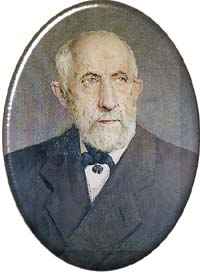<Back to Index>
- Physicist Orest Danilovich Khvolson, 1852
- Painter Wassily Wassilyevich Kandinsky, 1866
- Dictator of Spain Francisco Paulino Hermenegildo Teódulo de Franco y Bahamonde, 1892
PAGE SPONSOR

Orest Danilovich Khvolson or Chwolson (Russian: Орест Данилович Хвольсон) (November 22 (N.S. December 4), 1852, Saint Petersburg - May 11, 1934, Leningrad) was a Russian physicist and honorary member of the Soviet Academy of Sciences (1920). He is most noted for being one of the first to study the gravitational lens effect.
Orest, son of the noted Orientalist Daniel Chwolson, graduated from St. Petersburg University in 1873. He began teaching at his alma mater in 1876 and would become a professor in 1891. Orest Khvolson authored a number of works on electricity, magnetism, photometry, and actinometry. He proposed the designs of an actinometer and a pyrheliometer, which would be used by the Russian weather stations for a long time. After 1896, Khvolson was mainly engaged in compiling the five volume Physics Course (Курс физики), which would improve immensely the teaching of physics throughout the country and remain a principal textbook in universities for years to come. It was even translated into the German, French, and Spanish languages.
His most noted accomplishment occurred in 1924, when he published about gravitational lenses in Astronomische Nachrichten, a scientific journal on astronomy. The concept of gravitational lenses, did not get much attention until 1936, when Albert Einstein wrote about the gravitational lens effect. The observation of a gravitational lens, where one source (sun or galaxy) produces a ring around another source, is referred to as a Chwolson ring, or Einstein ring.
He became an honorary member of the Soviet Academy of Sciences and was awarded the Order of the Red Banner of Labor. The crater Khvolson on the Moon is named after him.